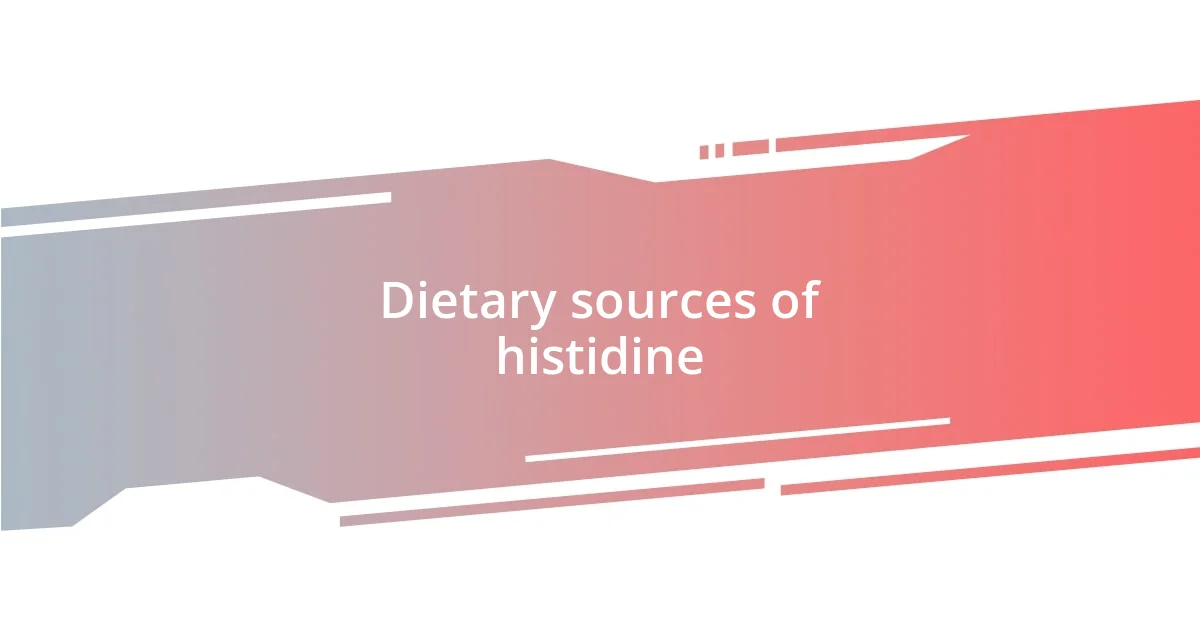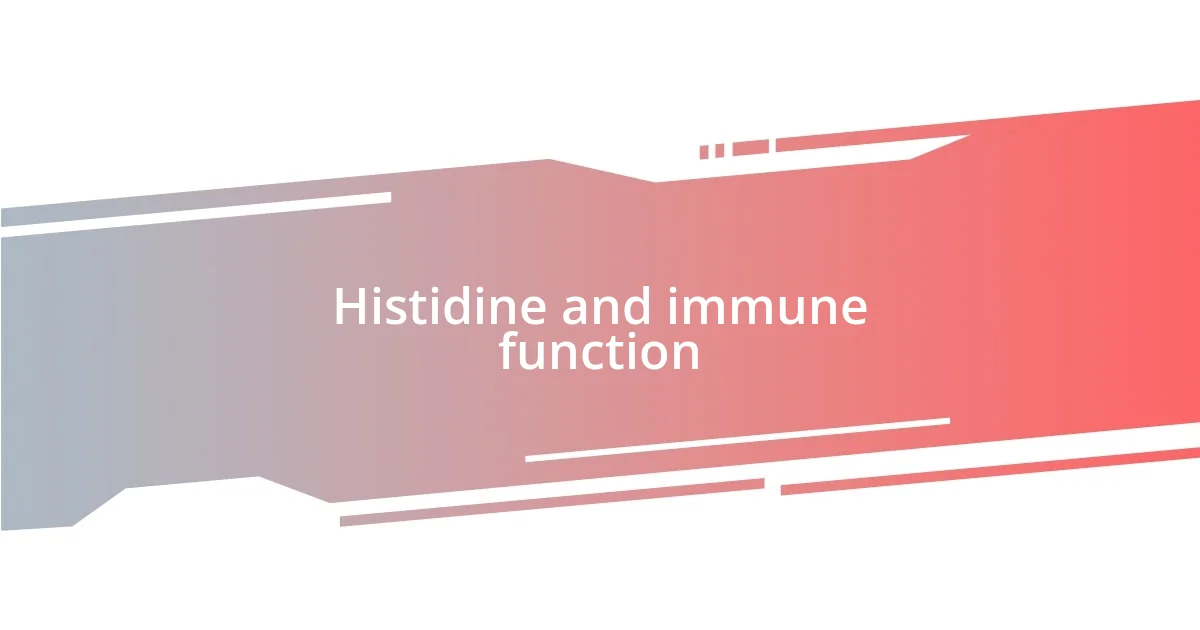Key takeaways:
- Histidine is essential for immune function, muscle recovery, and cognitive support, highlighting its significant role in overall health.
- Incorporating histidine-rich foods like lean meats, dairy, quinoa, and soybeans can enhance energy levels, recovery, and mental clarity.
- A deficiency in histidine can lead to weakened immune responses, impaired muscle recovery, and hormonal imbalances, underscoring the importance of adequate intake.

Understanding histidine benefits
Histidine is an essential amino acid that plays a crucial role in various bodily functions, and I’ve always found its significance fascinating. Did you know it helps with the production of histamine? This is vital for our immune response and digestion. When I learned about this connection, it made me appreciate how interconnected our body systems truly are.
In my experience, exploring histidine’s benefits also revealed its role in promoting healthy muscle growth and repair. Remember that time you pushed yourself too hard at the gym? I certainly do! Supplementing with histidine could have helped speed up my recovery. It’s amazing how something as simple as an amino acid can influence our daily lives and athletic performance.
Moreover, I can’t help but reflect on how histidine is involved in the synthesis of carnosine, a compound that helps buffer acid in muscles. Have you ever felt that burning sensation during an intense workout? Carnosine’s protective effects against fatigue can make a significant difference. Understanding these benefits truly emphasizes how small nutrients can lead to substantial changes in our health and well-being.

Importance of histidine in health
Histidine is essential for maintaining overall health, impacting everything from tissue repair to mental well-being. Personally, I’ve noticed that when I prioritize foods rich in histidine, like lean meats and dairy, I often feel more energized and focused throughout the day. This amino acid also supports the production of neurotransmitters, which can enhance our mood and cognitive function.
To summarize, here are a few key health benefits of histidine:
- Supports the production of histamine, crucial for immune response and digestion.
- Aids in tissue repair and muscle recovery, especially valuable after workouts.
- Contributes to cognitive function by aiding neurotransmitter synthesis.
- Acts as an antioxidant, helping combat oxidative stress in the body.
- May help regulate blood sugar levels and support metabolic health.
Each of these points resonates with my own experiences in both physical and mental wellness. I find it remarkable how a single amino acid can weave such a rich tapestry of benefits in our daily lives.

Dietary sources of histidine
When considering dietary sources of histidine, I find that a variety of foods can boost our intake effectively. Lean meats like chicken and turkey are among the top sources; they not only help in muscle growth but also keep you feeling satiated. I remember when I incorporated more turkey into my meals—I noticed a considerable increase in my energy levels, especially during my afternoon slump.
Dairy products like milk and yogurt also pack a punch with histidine. I’ve often relied on a yogurt smoothie for breakfast, and the benefits are evident. Not only do I feel mentally sharp throughout the morning, but my body seems to recover faster after a good workout.
As for plant-based options, foods like quinoa and soybeans are excellent choices for histidine. While I wasn’t always mindful of my histidine consumption, discovering these sources has made me more intentional about balancing my meals. It’s enlightening to see how easy it can be to incorporate this essential amino acid into our diets, regardless of dietary preferences.
| Food Source | Histidine Content (per 100g) |
|---|---|
| Chicken Breast | 1.24g |
| Turkey | 0.99g |
| Milk | 0.12g |
| Yogurt | 0.15g |
| Quinoa | 0.65g |
| Soybeans | 0.58g |

Histidine’s role in muscle growth
Histidine plays a fascinating role in muscle growth that often flies under the radar. I remember the first time I noticed a significant difference in my recovery time after intense workouts. It was when I added more histidine-rich foods to my diet, like chicken and quinoa. My muscles felt less sore and more ready to tackle the next session, which only fueled my motivation.
What’s intriguing is how histidine contributes to protein synthesis, the process our bodies use to repair and build muscle fibers. When I first learned about this, it clicked for me why a balanced intake of amino acids, especially histidine, is crucial after exercise. Failing to optimize my post-workout nutrition left me fatigued and struggling to see the gains I wanted. Now, I actively seek out those histidine-rich snacks right after hitting the gym.
Moreover, histidine aids in the production of carnosine, a compound that helps buffer acidity in muscles during intense exercise. This was a game-changer for me when I experienced how it improved my endurance. I can still recall the rush I felt during those last few reps when I was able to push through without that burning sensation in my muscles. It makes me wonder—what might my performance look like if I hadn’t focused on including histidine in my diet? The benefits of this amino acid are undeniable, and I think it’s time to give it the recognition it deserves in the world of fitness and nutrition.

Histidine and immune function
Histidine plays a significant role in supporting our immune function, acting as a precursor for histamine. This compound is vital for regulating immune responses, and I’ve noticed that when I include histidine-rich foods in my meals, I tend to feel more resilient against the common cold. Have you ever experienced that nagging feeling of getting sick but then bounced back quickly? I believe my focus on histidine is a key factor in this recovery.
The connection between histidine and the immune system goes beyond just histamine production. It’s also linked to the production of various immune cells, which has made me rethink my approach to nutrition during flu season. I recall a time when I upped my intake of chicken and yogurt during a particularly nasty wave of illness around me. Not only did I avoid that bug, but I felt fantastic overall—a win-win for my health!
Moreover, I find it fascinating how a simple amino acid like histidine can influence the body’s defense mechanism so profoundly. When I think about it, it makes perfect sense; maintaining a strong immune system is just as critical as muscle recovery. Considering the challenge of staying healthy in today’s world, what if including more histidine could be a simple yet effective strategy? Every little bit helps, and it’s reassuring to know that the right foods can truly make a difference.

Potential risks of histidine deficiency
If histidine levels dip too low, the consequences can be quite concerning. Personally, I’ve noticed when I feel fatigued or mentally foggy, it sometimes correlates with my lack of attention to amino acid intake. This got me wondering—how often do we overlook the signs our body gives us? A deficiency in histidine can lead to weakened immune function and impaired muscle recovery, leaving us susceptible to illness and injury.
Additionally, a deficit can affect our hormonal balance, especially in regulating stress. I recall a stressful period in my life when I felt overwhelmed and irritable. It wasn’t until I adjusted my diet, focusing more on nutrient-rich foods, that I realized how much my nutrition could influence my mood. Can you imagine feeling consistently on edge simply due to an insufficient amount of histidine? That realization was a bit of a wake-up call for me.
Moreover, I’ve come across studies suggesting that insufficient histidine may hinder our body’s ability to produce hemoglobin, the protein responsible for carrying oxygen in our blood. If you’ve ever experienced shortness of breath during workouts, like I have, you might want to consider how underlying nutrient deficiencies could be playing a role. It’s fascinating yet somewhat alarming to think that a simple amino acid deficiency could have such a ripple effect on both our physical and mental well-being.

How to supplement histidine safely
When considering histidine supplementation, it’s essential to consult with a healthcare professional before starting. I remember my initial foray into supplementation when my energy levels plummeted during a busy work season. I sought guidance from a nutritionist, who emphasized the importance of getting the right dosage tailored to my specific needs rather than jumping in blindly. Have you thought about how a tailored approach could set you on the path to success?
I’ve learned that incorporating histidine-rich foods into your diet is often preferred over supplements. For me, adding more foods like tuna and lentils has been game-changing. The meals are not just tasty; they also keep me feeling energized and healthy. Have you ever considered how simple dietary changes could have a profound impact on your daily routine?
If you do decide to use histidine supplements, starting with a low dose and gradually increasing it is wise. I once made the mistake of taking too much too quickly, feeling overstimulated and a bit anxious. Since then, I’ve found that moderation is key. Have you experienced the importance of pacing yourself with any new health regimen? Balancing supplementation with a mindful approach to nutrition has made all the difference for me.













